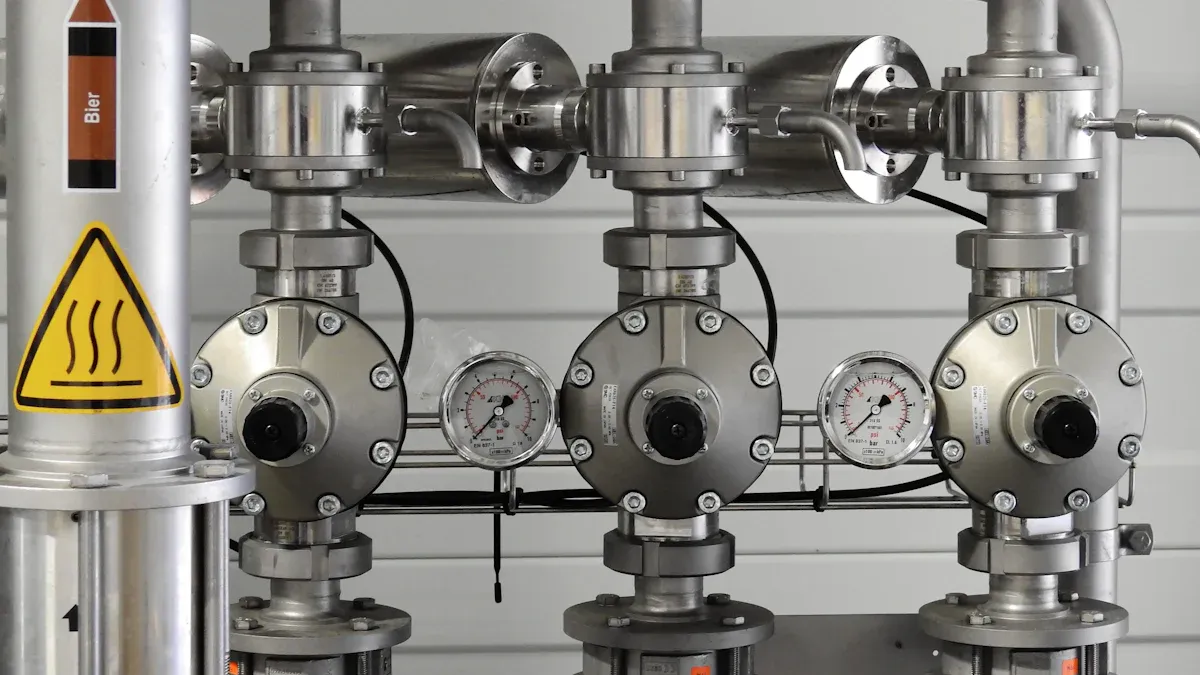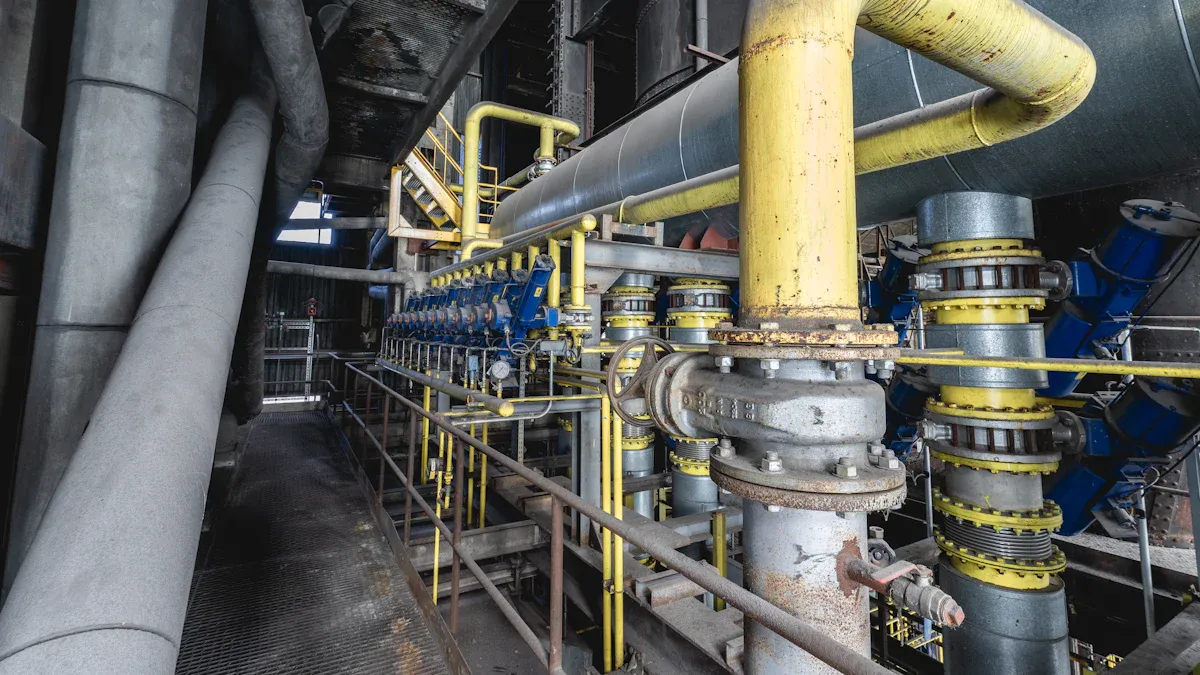
Reducing maintenance costs has become a critical goal for industrial facilities worldwide. A German plant faced rising costs due to frequent equipment failures and inefficient systems. By integrating a solenoid valve into their operations, the facility achieved significant savings. This innovation not only reduced expenses but also improved reliability, setting a benchmark for similar industries.
Key Takeaways
- Using solenoid valves can lower maintenance costs by needing fewer repairs.
- Solenoid valves work quickly and save energy, making production smoother.
- Buying good parts like solenoid valves makes machines last longer and work better.
Background and Challenges
The German Plant’s Maintenance Cost Issues
The German plant faced escalating maintenance costs due to frequent equipment breakdowns. Their aging systems required constant repairs, which drained resources and disrupted operations. Maintenance teams struggled to keep up with the demand for replacements and repairs. This led to increased downtime and reduced productivity. The financial strain became a significant concern for the management team, as they sought ways to optimize their budget without compromising operational efficiency.
Operational Challenges Affecting Efficiency
In addition to high maintenance costs, the plant encountered operational inefficiencies. Equipment failures often occurred during critical production periods, causing delays and missed deadlines. The inconsistent performance of outdated components created bottlenecks in the production process. Maintenance schedules were unpredictable, making it difficult to plan for routine servicing. These challenges not only affected the plant’s output but also impacted employee morale, as teams worked under constant pressure to resolve issues.
The Need for a Cost-Effective Solution
The management team recognized the need for a reliable and cost-effective solution to address these challenges. They required a system that could reduce maintenance demands while improving overall efficiency. After evaluating various options, they identified solenoid valves as a potential solution. These valves offered durability, precision, and minimal maintenance requirements. The team believed that implementing this technology could significantly reduce costs and enhance operational reliability.
The Solution: Implementing Solenoid Valves

Why Solenoid Valves Were the Ideal Choice
The management team at the German plant selected solenoid valves after a thorough evaluation of their operational needs. These valves stood out due to their ability to provide precise control over fluid and gas flow. Unlike traditional mechanical valves, solenoid valves operate using electromagnetic principles, which reduce the need for manual intervention. This feature aligned perfectly with the plant’s goal of minimizing maintenance demands.
Another key factor was their durability. Solenoid valves are designed to withstand harsh industrial environments, including exposure to high temperatures and corrosive materials. Their robust construction ensures a longer lifespan, which translates to fewer replacements and repairs. Additionally, their compact design made them easy to integrate into the plant’s existing systems without requiring significant modifications.
Tip: Solenoid valves are particularly effective in applications where reliability and precision are critical, making them a versatile choice for various industries.
Key Features of the Solenoid Valve Solution
The solenoid valve solution implemented at the plant offered several advanced features that addressed their challenges:
- Low Maintenance Requirements: The valves required minimal servicing, significantly reducing the workload on the maintenance team.
- Energy Efficiency: These valves consumed less power compared to older systems, contributing to overall cost savings.
- Fast Response Time: Solenoid valves operate almost instantaneously, ensuring smooth and uninterrupted production processes.
- Customizable Configurations: The valves could be tailored to meet specific operational needs, enhancing their versatility.
- Enhanced Safety: Built-in fail-safe mechanisms ensured that the valves would default to a safe position during power outages or system failures.
These features collectively improved the plant’s operational efficiency while addressing their primary concern—high maintenance costs.
Implementation Process and Timeline
The implementation of solenoid valves at the German plant followed a structured approach to ensure minimal disruption to ongoing operations. The process began with a detailed assessment of the plant’s existing systems. Engineers identified areas where solenoid valves could replace outdated components without compromising functionality.
The installation phase was carried out in stages. This phased approach allowed the plant to continue its production activities while gradually integrating the new technology. Each stage included rigorous testing to ensure the valves performed as expected under real-world conditions. The entire implementation process, from initial assessment to full integration, was completed within three months.
Note: The plant’s management credited the smooth implementation to the collaborative efforts of their in-house team and the solenoid valve supplier’s technical experts.
The successful deployment of solenoid valves not only resolved the plant’s immediate challenges but also laid the groundwork for long-term operational improvements.
Results and Benefits

Reduction in Maintenance Costs
The implementation of solenoid valves significantly reduced the German plant’s maintenance expenses. These valves required minimal servicing due to their durable construction and reliable performance. Unlike the older components, which frequently broke down, the solenoid valves operated consistently over extended periods. This reduced the need for frequent repairs and replacements, leading to substantial cost savings.
The maintenance team also reported a noticeable decrease in the time spent on routine inspections. With fewer breakdowns, they could allocate their resources more effectively, focusing on other critical areas of the plant. The reduction in maintenance costs not only improved the plant’s financial health but also allowed the management to reinvest in other operational improvements.
Insight: A well-maintained system with durable components, such as solenoid valves, can drastically cut down on unexpected expenses.
Improved Operational Efficiency
The introduction of solenoid valves brought a new level of efficiency to the plant’s operations. Their fast response time ensured that production processes ran smoothly without interruptions. The precise control over fluid and gas flow eliminated bottlenecks, allowing the plant to meet production targets consistently.
Additionally, the energy-efficient design of the solenoid valves contributed to overall cost savings. By consuming less power, these valves reduced the plant’s energy bills while maintaining optimal performance. The customizable configurations also allowed the plant to adapt the valves to specific operational needs, further enhancing efficiency.
The streamlined operations had a positive impact on employee productivity. With fewer disruptions, workers could focus on their tasks without the stress of constant equipment failures. This improvement in workflow translated into higher output and better morale across the workforce.
Enhanced Reliability and Downtime Reduction
Reliability became a hallmark of the plant’s operations after the integration of solenoid valves. These valves demonstrated exceptional performance even under harsh industrial conditions. Their robust design minimized the risk of failure, ensuring uninterrupted production cycles.
The plant experienced a significant reduction in downtime, which had previously been a major challenge. The fail-safe mechanisms built into the solenoid valves provided an added layer of security. In the event of a power outage or system failure, the valves defaulted to a safe position, preventing potential damage to the equipment.
This enhanced reliability not only improved the plant’s operational stability but also strengthened its reputation among clients. Consistently meeting deadlines and maintaining high-quality standards became achievable goals, thanks to the dependable performance of the solenoid valves.
Takeaway: Investing in reliable components like solenoid valves can lead to long-term benefits, including reduced downtime and improved customer satisfaction.
Customer Perspective
Feedback from the Plant’s Maintenance Team
The maintenance team at the German plant expressed satisfaction with the performance of the newly implemented solenoid valves. They highlighted the significant reduction in their workload, as the valves required minimal servicing. Team members noted that the durable construction of the valves eliminated frequent breakdowns, which had previously consumed a large portion of their time and resources.
One technician mentioned that the streamlined maintenance schedule allowed them to focus on preventive measures rather than constant repairs. This shift improved the overall efficiency of the team. Additionally, the team appreciated the user-friendly design of the valves, which simplified installation and routine inspections. The enhanced reliability of the system also reduced stress levels among the staff, fostering a more productive work environment.
Quotes Highlighting the Benefits of Solenoid Valves
The plant’s maintenance team shared several positive remarks about the solenoid valves. Below are some of their key statements:
- “These valves have transformed our daily operations. We no longer deal with unexpected failures disrupting production.”
- “The energy efficiency of the solenoid valves has noticeably reduced our operational costs.”
- “Their fail-safe mechanisms give us peace of mind, especially during power outages.”
- “The compact design made integration seamless, saving us time during installation.”
These testimonials underscore the tangible benefits of the solenoid valve solution, from cost savings to improved operational stability. The feedback reflects the team’s confidence in the technology and its long-term value for the plant.
The German plant’s journey highlights how solenoid valves addressed rising maintenance costs and operational inefficiencies. Their durability, precision, and energy efficiency delivered measurable results.
Key Takeaway: Industrial facilities can achieve cost savings and reliability by adopting advanced solutions like solenoid valves.
Explore solenoid valve options today to transform your operations.
FAQ
What industries can benefit from solenoid valves?
Solenoid valves suit industries like manufacturing, chemical processing, food production, and water treatment. Their precision and reliability make them versatile for various applications.
How long do solenoid valves typically last?
With proper maintenance, solenoid valves can last several years. Their durable construction ensures extended performance even in harsh industrial environments.
Are solenoid valves energy-efficient?
Yes, solenoid valves consume minimal power during operation. Their energy-efficient design helps reduce overall operational costs for industrial facilities.
Post time: Apr-18-2025
